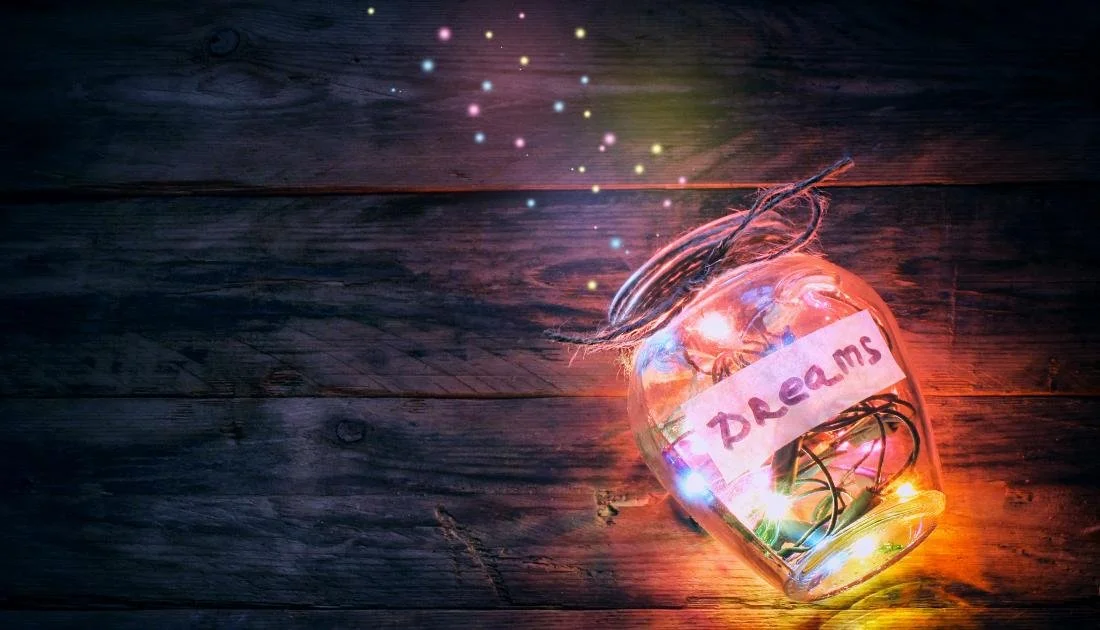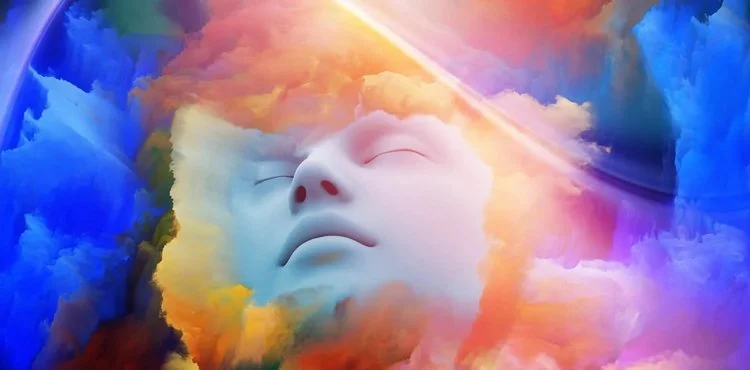Why do we dream?
Over the years I’ve had a recurring dream about a little girl running in a forest during a thunderstorm. She makes it to a cliff, turns around, then jumps into a black abyss. I’ve had that dream on and off since I was ten.
There are many theories about why we dream, a source of mystery for scientists and psychologists alike. Why do we dream? What do they mean? Can we control them?
why do we dream?
Dreams are stories we tell ourselves in the form of images. Although sometimes other senses are used too, especially if someone has been blind since birth.
There are lots of theories including — our unconscious playing out our desires and fears; random signals from our brain and body while we sleep; or processing and organizing information gathered during the day.
There are five stages of sleep including REM (rapid eye movement): where breathing becomes more rapid, eyes shift quickly all over the place, muscles become temporarily paralyzed, and heart rate and blood pressure increase. When people awaken during REM sleep, they often describe bizarre and illogical tales. According to neurologists, REM sleep is the most likely candidate for the case of dreaming.
From a memory perspective, I’m irresistibly drawn to the concept of offline processing where our brains consolidate what we’ve learned or experienced and then organizing the puzzle pieces to make sense. Sleep represents a critical mode for our bodies to rejuvenate, but also our minds even though we never completely go “offline.”
When we were vacationing in Hawaii years ago we learned about dolphins. They alternate which half of their brains are sleeping. That way they can get the rest they need without ever losing consciousness. Some days when I’m operating at half speed, I figure I’m in dolphin mode.
“What does it mean when we dream?” Medical News Today*.
Fun Facts*
everyone is thought to dream 3 to 6 times per night
each dream lasts between 5 to 20 minutes
around 95% of dreams are forgotten before we get out of bed
dreaming can help you learn and develop long-term memories
the left hemisphere seems to provide dream origin while the right hemisphere provides dream vividness
what do dreams mean?
Sigmund Freud and Carl Jung are considered the founding fathers of psychoanalytical psychology. They have fundamentally shaped our understanding of modern psychology but had different approaches.
They both acknowledged the unconscious mind, but Jung placed more emphasis on an individual’s lived experiences and future aspirations. Jung conceptualized the idea of a collective unconsciousness. He believed dreams are messages, communicating information our conscious minds might have missed. Freud was pretty much focused on suppressed thoughts and repressed memories spilling out in our dreams.
Jung spent years exploring the concept of human connectedness with his patients and through his self-exploration using free-writing and dream analysis. The result of Jung’s “confrontation with the unconscious” is one of my favorite books: The Red Book, a large, illuminated volume he created between 1914 and 1930.
During this time he developed his principle theories—the archetypes, the collective unconscious, and the process of individuation—that transformed psychotherapy from a practice concerned with the treatment of the sick into a means for higher development of the personality — opening the doors to creativity.
*For dream symbolism, there are plenty of resources like dreambible.com fun to share with family and friends after a glass of wine at a dinner party.
can we control our dreams?
We spend years of our lives dreaming. Although we may remember aspects of our emotions and what happened in our dreams, we are not conscious. Some people are lucid dreamers they have the ability to experience awareness during their dreams by “re-awakening” some aspects of their waking consciousness. They can even take control and act with intention in the dream world (think Leonardo DiCaprio in the film Inception).
With my recurring childhood dream about the little girl I'm chasing but can't get to her in time, there are times when I replay that dream where I feel like I can influence the outcome. I try to make noise so she stops and lets me catch up. Or, I try to take a diagonal route to cut her off. But the results are always the same. She looks back at me and jumps off the cliff into a black abyss and I just stand there staring.
New research suggests dreams can help solve problems. Have you ever worked and chewed over some problem you had? What if you could direct your dreams? If you could ask a question before going to sleep, let it incubate while you sleep, and wake up with a new perspective?
Harvard Professor Deirdre Barrett straddles the worlds of academic psychology and neuroscience. In her book The Committee of Sleep: How Artists, Scientists, and Athletes Use Their Dreams for Creative Problem Solving, she delves into how dreams inform people’s work and how we can each apply the techniques.
why do we sleep?
Dreaming has lots of benefits for us and requires sleep to manifest. Other benefits according to Why We Sleep by Matthew Walker — “Sleep maintains a healthy microbiome, balances the body’s insulin and blood sugar levels, cleans the brain, maintains healthy testosterone levels (helping us focus), protects our DNA, enhances the function of every major organ, and strengthens our immune systems.”
The brain plasticity theory says sleep is required for brain function. Specifically, it allows your neurons to reorganize. When we sleep, our brain clears out waste from the central nervous system. It removes toxic byproducts from your brain, which build up throughout the day. This allows your brain to work well when you wake up.
Sleep also contributes to memory function by converting short-term memories into long-term memories, as well as by erasing, or forgetting, unneeded information that might otherwise clutter the nervous system.
how do dreams help creativity & problem-solving?
Over the decades I’ve been exposed to various types of free-writing techniques inspired by Jung’s “automatic-writings.” First with morning pages encouraged in The Artist’s Way which later lead to my early morning “before I wake up too much” poetry writing habit.
Over the last few years during COVID I’ve reacquainted myself with Natalie Goldberg who wrote Writing Down the Bones. I’ve nurtured my free-writing morning routine during coffee and this last year expanded the practice to include a writing group.
A common result of this writing technique captures aspects of my unconscious through my dreams. And as I categorize and organize themes, there’s a tremendous amount of creative raw material generated.
In 2010, researchers found that subjects were much better at getting through a complex 3-D maze if they had napped and dreamed of the maze prior to their second attempt. In fact, they were up to ten times better at it than those who only thought of the maze.
Next time you’re working on a problem at work or a relationship sticky point, try Dr. Barrett’s steps to help plant a seed in your brain while you sleep:
Write a problem or question down.
Review the problem or question minutes before going to bed.
In bed, visualize the situation as a concrete image.
Tell yourself you want to dream about the situation as you drift off.
Keep a pen and paper by your bedside.
Upon waking, lie quietly before getting out of bed. Note any trace of a dream and invite more of the dream to return if possible. Write it down.
Now, I have more appreciation for of the importance of sleep. While I’m partially offline biologically my body rejuvenates. During REM sleep physiologically my brain sorts, organizes, rehearses various scenarios, and some days feels like my internal board of directors has been very active all night handing me a long todo list when I wake up.
Often though, if I hold off jumping to the task list, there’s a quiet voice still lingering in the shadows between sleep and awakedness. I cherish writing down what she says first.
As for the little girl in my recurring dream, in the mid-1990s the dreams started again. Because I kept track of my dreams and asked what could they mean? it occurred to me … my eldest daughter was turning ten and her youngest sister turning three. The exact ages my little sister and I were when she died.
In a wave of recognition, I realized the girl in the dream was my sister and no matter what I did, I couldn’t save her. My subconscious got stuck on replay trying to control something out of my ten-year-old control. When I internalized that a part of me was still trying to save her, the dreams stopped. I can conjure the images, but it doesn’t come searching for me at night anymore.
What are your dreams trying to tell you?
Please leave a comment below and if you enjoyed this post, I invite you to subscribe to my thought echoes newsletter.




